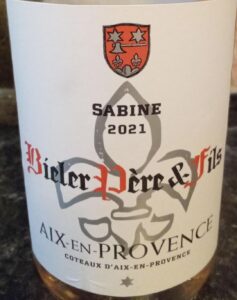“Like any good dry rosé, this pairs nicely with a variety of foods,
and it performs quite well as a solo sipper.”
(Update: I just found a goodly amount of this one at Market Fresh, located at 31201 Southfield Rd, Beverly Hills, MI, for $13.99! Now that’s a value!!! 4/14/23)
I’m always on the lookout for a good glass of dry rosé. It’s a wine for every season here in the underground, and, as it gains in popularity, there are ever more options available. We’re especially fond of Provence rosé, and we’ve enjoyed previous vintages of this one a number of times. Costco was selling it for a while, but hasn’t stocked it for a few years, so when I happened upon a stash yesterday during a scouting mission to Westborn Market in Berkley, I didn’t hesitate to pick one up and see what the current bottling has to offer. It turns out that it’s showing quite well, thank you very much.
2021 Bieler Pere et Fils Sabine Rosé Coteaux d’Aix-en-Provence, 33% Grenache, 26% Syrah, 14% Cabernet Sauvignon, 18% Cinsault, 9% Rolle, 12.5% alc., $15.99: Wow, this pale peachy pink is heavy on the mineral at first sip. It settles down right away, but minerality still figures prominently in the character of the wine, and that’s fine by me. Medium bodied, with good intensity, balanced acids and a watermelon and wet stone flavor profile, this baby is decidedly dry. It actually has some structure and may even improve over the next few years, but it’s a drink-me-tonight kind o’ wine for this taster. Like any good dry rosé, this pairs nicely with a variety of foods, and it performs quite well as a solo sipper. It is worth every penny of the price I paid for it, but it may be available in some retail outlets for even less. Either way, if you see it, buy it. Find this wine
As the oldest wine growing area in France and the world’s largest Rosé specialty region, Provence is the gold standard in Rosé. There are 8 different appellations in Provence but only 3 that you need to know: Cotes de Provence, Aix-en-Provence, and Bandol. Most of the biggest Rosé producers are in the Cotes de Provence AOC, where the warmest growing regions in the flats of Provence produce higher yields and harvests tend to be quite early. For our part, we instead focused on the cooler, more rugged and higher elevation vineyards in the hills around Aix-en-Provence. The cooler nights in the hills around Aix-en-Provence means that we pick on average 2 weeks later than Cotes de Provence, allowing for a gentler ripening and more natural acidity, two critical attributes to make the kind of Rosé we think is best. The Southern Rhone and Provence are on the front lines of global climate change and these relatively cooler sites in the region have become more important than ever to make wines with balance and energy.
We don’t want singular big flavors, we want more nuance, energy, soul and personality. To achieve that we don’t have a single approach to each fermentation. Instead, we break up each vineyard into parts using different yeasts, juice solids and lees treatments so each tank is a little different and brings a unique perspective in the final blend. We have been loving the results of circulating juice solids pre-fermentation to build depth and concentration. For a delicate, fresh wine like Rosé, oxygen contact can be crushing, so we have made investments in nitrogen coverage such that from the moment the fruit arrives it’s never exposed to oxygen again until it’s eventually poured from a bottle in to your glass, resulting in a more vivid and precise expression of our Rosé than ever before.
Imported by Bieler Père et Fils, St. Helena, CA
Reporting from Day-twah,
Bastardo



Pingback: Dry Rose x 3 | Tasting Notes from the Underground
Pingback: Another Classic Provence Rosé | Tasting Notes from the Underground